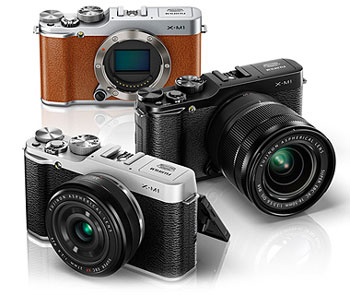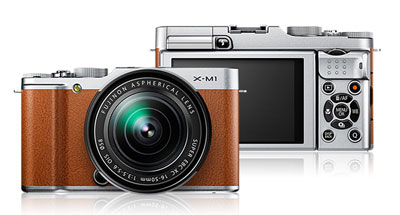Talk sensible product differentiation? Fujifilm is really milking the retro X series by targeting yet another model towards the masses. The Japanese camera maker just announced the latest X incarnation (it’s 4th, to be exact) with the X-A1, an entry-level X mirrorless with a beautiful design at downmarket price — with a conventional sensor. Up to now Fujifilm has installed the highly acclaimed X-Trans CMOS sensor only in cameras that cost, with lens, over a thousand dollars. The X-M1 is significantly cheaper, despite its quality sensor. The quick glance reveals where the manufacturer is cutting corners.
Yet, this cheapest Fujifilm X series camera is not really cheap: the X-M1 kit will cost just under $800 with the 16-50mm F3.5-5.6 OIS lens. Compared to compact cameras this is expensive, but the picture quality is severely better. The same X-Trans image sensor found in much more expensive models, such as the X-E1 and X-Pro1, is the core of the X-M1; a sensor that delivers stunningly detailed, sharp and clean files even at higher ISO speeds. Fujifilm is the first camera maker to offer such imager technology at the price level of the X-M1.

The LCD screen is just fine. There’s now viewfinder, so when composing you depend solely on the monitor. Neither can a digital viewfinder be retrofitted. Maybe that’s the reason why Fujifilm has equipped this camera with a better monitor than the pricier X-E1.
With a resolution of 920K dots the screen is twice as detailed as the X-E1’s. In addition, you can move the monitor up and down until it protrudes at a 90° angle. Set correctly, you can display images and work the menu even in bright sunshine, despite glare and reflections. Not ideal, but still better than many competing models.
Image quality? The pictures are exceptionally rich in detail, clear and noise-free for a camera with an image sensor of this APS-C size. Shooting in difficult light? The signal-to-noise ratio drops below the critical limit only above the high ISO 3,200 sensitivity, at which point interferences overlay the image signals.

A few word on the X-M1’s operation: it’s a new trend that manufacturers save on a camera’s controls in cheaper models. Pay less for the casing, but you have to operate with more screen menus. Fujifilm has its own approach with the X-M1:
In some of the cheaper, new camera lenses that come on the market, the aperture ring is missing. Instead you can set the aperture and the exposure time manually using a rotary control on the X-M1 casing. There is a cog for the right thumb and one for the index finger, in addition to 10 other switches and the mode dial.
The X-M1 features Fujifilm’s excellent Q menu for quickly changing key settings as well as in-camera RAW conversion (which helps get the most out of the excellent JPEG engine). Overall, it’s very easy to handle the camera with these interfaces, and not to forget the built-in flash. The only fly in the ointment: the functions of the rotating wheels cannot be reprogrammed.
What’s not so admirable about the X-M1? Autofocus and Wi-Fi. The focusing speed is not the reason why you buy the X-M1. This is a camera that asks for patience and the willingness to operate and focus manually now and then. The camera’s AF is a bit slower than the X-E1’s — sufficient for street photography and, of course, static subjects. For kids? Fast moving scenes? Sports? Running dogs? Not your first choice.
There are many cameras with similar sensor surfaces that work faster. You remember that the earlier X models had AF performance issues. Maybe firmware updates will accelerate things. Until then AF is a bit of a hit and miss gamble.
Inevitably a few other features are missing — for example there’s no microphone input for movie recording, and disappointingly no electronic level display. The camera has a built-in Wi-Fi module, but the corresponding Fujifilm camera app for iOS and Android does not allow for remote control.
So all in all you get excellent handling and image quality in the by far most compact body of Fujifilm’s X series system cameras. Colors are superb, noise is not an issue even at maximum ISO 6,400 sensitivity. The X-M1 offers above-average output for a camera in this price and size range. The price is certainly on the inexpensive side given the quality provided. It’s a great camera for those on a slightly tighter budget who value a great sensor and work with semi-automatic or manual controls.
Last but not least, you get a great camera mojo with the X-M1’s stylish, minimalist, retro design. It’s a solid performer reduced to the essentials enabling great photography. Just don’t complain about AF speed, the kit lens and the relatively small lens selection. There’s only a limited market for second hand offers. XF lens prices are high.
Also, if you want faster maximum shutter speed, better movie mode and no lack of ISO 100, go for the slightly more enjoyable X-E1.
+++ You can order the Fujifilm X-M1 from Amazon, B&H and Adorama.


